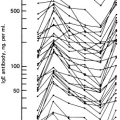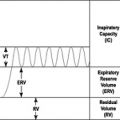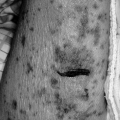Chronic Cough
Rachel E. Story
Jennifer S. Kim
Introduction
Cough is the most common complaint for which Americans see a primary care physician (1). In the United States, the cost of over-the-counter medications to treat cough is estimated to exceed two billion dollars on an annual basis (2). The differential diagnosis, diagnostic evaluation, and treatment of cough differ in children and adults. This chapter will focus on chronic cough and discuss children and adults separately.
Cough is a reflex response of the lower respiratory tract that is mediated by cough receptors of the airways. Cough receptors are present also in the pharynx, paranasal sinuses, stomach, and external auditory canal.
Cough in Adults
Cough in adults (patients 15 years or older) is categorized in three groups: acute cough lasting less than 3 weeks, subacute cough lasting 3 to 8 weeks, and chronic cough lasting longer than 8 weeks. Detailed discussion of each group is beyond the scope of this chapter. Acute cough is usually infectious in nature. Subacute cough is often post-infectious but can also represent the onset or exacerbation of conditions known to cause chronic cough. This chapter will focus on chronic cough in nonsmokers as it is one of the most common reasons patients seek care from a respiratory specialist.
Chronic cough occurs in 10% to 20% of adults and can be debilitating (3). Complications of cough include almost every organ system and have been shown to significantly decrease quality of life (4–7). Three conditions cause the majority of cough in nonsmoking adults who are not on an angiotensin-converting enzyme (ACE) inhibitor: upper airway cough syndrome, asthma, and gastroesophageal reflux disease (GERD). In patients with a normal chest radiograph and no symptoms suggesting a specific etiology of cough, a recent consensus document recommends investigation and treatment of upper airway cough syndrome, asthma, and GERD prior to the consideration of less common causes of cough (8). A comprehensive differential diagnosis for chronic cough in adults is included in Table 41.1.
Table 41.1 Differential Diagnosis of Cough in Adults | ||||||||||||||||||||||||
|---|---|---|---|---|---|---|---|---|---|---|---|---|---|---|---|---|---|---|---|---|---|---|---|---|
|
Upper Airway Cough Syndrome
Upper airway cough syndrome (UACS) was formerly known as the postnasal drip (PND) syndrome. UACS alone or in combination with other conditions is the most common cause of chronic cough (8). PND, the drainage of secretions from the nose or paranasal sinuses into the pharynx, causes cough via mechanical stimulation of the cough reflex, increased cough receptor sensitivity, or co-existent inflammation in the lower airways (9,10). Causes of UACS include allergic rhinitis, nonallergic rhinitis, vasomotor rhinitis, nonallergic rhinitis with eosinophilia, rhinitis medimentosa, gustatory rhinitis, infectious rhinitis, infectious sinusitis, allergic fungal sinusitis, rhinitis of pregnancy, and chemical/occupational rhinitis. These conditions, their diagnosis, and specific treatments are discussed in detail in Chapters 26 and 27.
History and physical examination alone will rarely identify the cause of chronic cough. Often, patients with UACS will report the sensation of mucus dripping down their throat and frequent throat clearing. On physical examination mucoid or mucopurulent secretions may be present and cobblestone changes in the oropharynx may be noted. However, 20% of patients with cough due to UACS do not report symptoms of PND and more than 50% do not have physical examination with characteristic changes (11). A prospective study of chronic cough in adults found that medical history regarding the character and timing of cough is of little value in determining the etiology of cough (12).
Treatment of UACS depends on its etiology. If there is an apparent etiology for UACS such as chronic rhinosinusitis or allergic rhinitis, appropriate treatment with antibiotics or intranasal steroids should be instituted. However, if a specific etiology is not clear, a diagnostic/therapeutic trial with antihistamine/decongestants or nasal steroids is recommended by the American College of Chest Physicians (ACCP) prior to investigating less
common causes of cough (8). Cough due to UACS typically resolves over a period of days to weeks with treatment. If a patient’s cough does not respond to empiric treatment and UACS is still suspected, the ACCP recommends a sinus CT as chronic rhinosinusitis may cause a cough without typical sinusitis symptoms.
common causes of cough (8). Cough due to UACS typically resolves over a period of days to weeks with treatment. If a patient’s cough does not respond to empiric treatment and UACS is still suspected, the ACCP recommends a sinus CT as chronic rhinosinusitis may cause a cough without typical sinusitis symptoms.
Asthma
Asthma should be considered in all adults with chronic cough. While cough is a common symptom of asthma, most patients experience dyspnea and wheezing in addition to cough. Still, some patients with asthma have cough as their predominant symptom and this condition is referred to as cough variant asthma (CVA), also called cough equivalent asthma. Patients with CVA have a more sensitive cough reflex than healthy volunteers and patients with typical asthma (13). If reversible airflow obstruction is found on spirometry, treatment with inhaled corticosteroids and bronchodilators should be instituted. At times leukotriene antagonists, long-acting β agonists, and oral steroids may be used as discussed in Chapter 19.
In a patient with a normal physical examination and normal spirometry, a methacholine inhalation challenge (MIC) essentially rules out the diagnosis of asthma as it has a negative predictive value close to 100% (14). There is a risk of a false positive study and one prospective study of chronic cough in adults found the MIC was falsely positive 22% of the time (15). Thus, diagnosis of CVA is made only after resolution of cough with specific asthma treatment (16). A diagnostic or therapeutic trial of asthma therapy is often performed. If MIC testing is not performed, nonasthmatic eosinophilic bronchitis cannot be excluded as the etiology of the cough as discussed in detail later in this chapter.
Gastroesophageal Reflux Disease
GERD causes cough via chemical and mechanical irritation of the upper respiratory tract, irritation of the lower respiratory tract via microaspiration, and stimulating an esophageal-bronchial cough reflex (17). Intervention studies find GERD alone or in combination with other etiologies as a cause of cough in up to 41% of adults with chronic cough (18). History regarding the character and timing of cough is not sufficient to distinguish a cough due to GERD from other causes of cough. One study found that cough due to GERD occurs at night in only a minority of patients (12). In addition, GERD is “silent” with no gastrointestinal symptoms in up to 75% of patients (19). GERD is the cause of chronic cough in 91% of nonsmoking adults with a normal chest radiograph if asthma, nonasthmatic eosinophilic bronchitis, UACS, and ACE-inhibitor cough have been ruled out (18).
Empiric treatment with medical anti-reflux therapy is warranted when GERD is the likely cause of cough. This includes patients with typical symptoms of regurgitation and heartburn and those with a high likelihood of GERD-related cough, that is, patients in whom asthma, nonasthmatic eosinophilic bronchitis, and UACS have been ruled out. Medical treatment of GERD includes dietary and lifestyle modification, acid suppression therapy, and in some cases prokinetic therapy. Some experts recommend a 24-hour esophageal pH monitoring prior to treatment of GERD while the ACCP recommends empiric treatment of GERD prior to 24- hour esophageal pH monitoring (18). The 24-hour esophageal pH monitoring has limitations in that it will not detect nonacid reflux and can result in a normal study when nonacid GERD is the cause of cough (20). In addition, there is disagreement on how best to interpret test results. Diagnosis is confirmed when cough resolves with GERD therapy. Typically patients should be treated with a proton pump inhibitor for at least 3 months as cough due to GERD may take longer to resolve with treatment than cough due to other causes (21).
When UACS, asthma, and GERD have been ruled out as a cause of cough, other diagnoses should be investigated, with the workup being guided by the clinical picture.
Nonasthmatic Eosinophilic Bronchitis
Nonasthmatic eosinophilic bronchitis is a common cause of chronic cough characterized by corticosteroid responsive eosinophilic airway inflammation without variable airway obstruction or airway hyperresponsiveness. Recent studies have found that between 10% and 30% of cases of chronic cough are caused by nonasthmatic eosinophilic bronchitis (22–24). Patients with nonasthmatic eosinophilic bronchitis have chronic cough with no reversible airway obstruction on spirometry, normal airway hyperresponsiveness on MIC, and sputum eosinophilia. Because cough typically resolves with inhaled corticosteroids, this condition was likely unrecognized in the past and misdiagnosed as asthma if MIC was not performed.
Primary Pulmonary Disease
Primary pulmonary disease is a less common cause of chronic cough with varying frequency depending on the population studied. One prospective study of chronic cough found bronchiectasis and interstitial lung disease as the etiology of cough in 16% of participants (25). In this study, a productive cough and an abnormal chest radiograph were predictive of a primary pulmonary cause of cough; however, other groups have not found chest radiograph to be predictive.
Bronchiectasis
Acute and chronic infection resulting in the permanent dilation of bronchi causes most cases of bronchiectasis (26). Due to improvements in the prevention and treatment of childhood infections with immunizations and antibiotics, there is a decrease in the incidence of bronchiectasis in immunocompetent individuals (27). In developed countries, patients with bronchiectasis often have an underlying disorder that predisposes them to the development of bronchiectasis; such disorders include cystic fibrosis, allergic bronchopulmonary mycosis, hypogammaglobulinemia, HIV, primary ciliary dyskinesia, chronic mycobacterium avium complex infection, aspiration, rheumatoid arthritis, inflammatory bowel disease, and α-1 antitrypsin deficiency (26). Patients typically present with a chronic productive cough and diagnosis is made when characteristic changes are found on high-resolution computed tomography (CT) of the chest (28). Treatment includes the use of bronchodilators, chest physiotherapy, antibiotics, and mucolytics.
Interstitial Lung Disease
The interstitial lung diseases (ILDs) are a heterogeneous group of pulmonary disorders that involve the alveolar and perialveolar tissues. They can be classified into those with known causes and those without a known cause. Known causes of ILDs include environmental and occupational exposures resulting in diseases such as asbestosis, hypersensitivity pneumonitis, and berylliosis. Unknown causes of ILDs include idiopathic pulmonary fibrosis, sarcoidosis, and ILD associated with collagen vascular disease. In patients with chronic cough, ILDs should be investigated after more common causes of cough have been ruled out, especially if history or chest radiography is suggestive (29).
Tracheobronchial Collapse
One prospective study of 78 patients found that 11 patients (14.1%) had tracheobronchial collapse as a cause of chronic cough (30). Tracheobronchial collapse was diagnosed on bronchoscopy and surgical correction was recommended. In that study, asthma, GERD, and UACS, alone or in combination, were responsible for 93.6% of chronic cough cases (30).
Lung Tumors
While cough is often a presenting symptom of lung cancer, it is still a rare cause of cough (<2%) in patients presenting with chronic cough (31). A chest radiograph should be obtained in those with known risk factors for lung cancer including cigarette smokers, those with passive cigarette smoke exposure, exposure to asbestos or radon, chronic obstructive pulmonary disease, or a
family history of lung cancer. Likewise, individuals with known cancer that may metastasize to the lung should have chest radiography performed. CT scans and bronchoscopy may be required if there is a high degree of suspicion and a normal chest radiograph.
family history of lung cancer. Likewise, individuals with known cancer that may metastasize to the lung should have chest radiography performed. CT scans and bronchoscopy may be required if there is a high degree of suspicion and a normal chest radiograph.
Infection
Infection is not a major cause of chronic cough but it must be considered in the differential in the appropriate clinical context. Because cough is the most common symptom in active pulmonary tuberculosis (TB), it should be considered in any patient with cough lasting 2 to 3 weeks if the likelihood of active TB is high (32). High-risk groups include those living in endemic areas, HIV seropositive individuals, prisoners, and those living in nursing homes. It is important to recognize that elderly patients will present with productive cough but are less likely to have fever, diaphoresis, hemoptysis, and a positive tuberculin skin test result (33). Thus, one must have a high index of suspicion when considering TB in an elderly population. If tuberculosis is suspected, a tuberculin skin test, chest radiograph, and sputum smears and cultures for acid-fast bacilli should be obtained. Pertussis is commonly thought of as a disease of children, but can cause chronic cough in adults. In a study of adults presenting to the emergency department complaining of cough for more than 2 weeks, 21% were found to meet serologic criteria for pertussis infection (34). Endemic fungi and parasitic disease should also be considered in patients visiting or residing in endemic locations.








